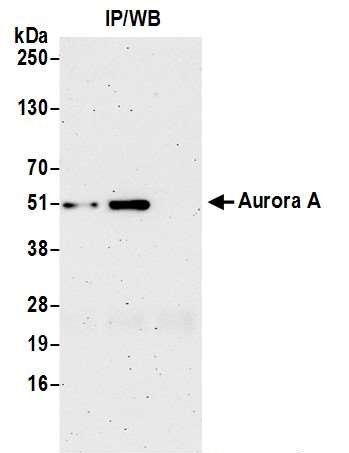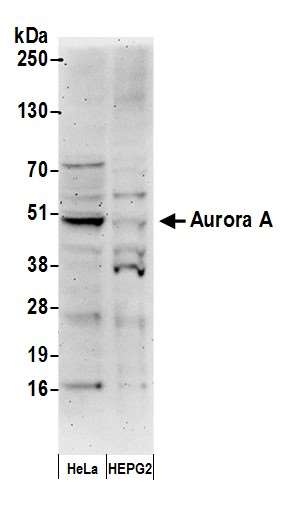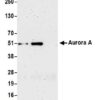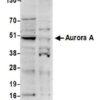Anti-Aurora A/STK15 Antibody (13042)
$518.00
SKU: 13042
Categories: Antibody Products, Enzymes and Enzyme Inhibitor Antibodies, Products
Overview
Product Name Anti-Aurora A/STK15 Antibody (13042)
Description Anti-STK15 Rabbit Polyclonal Antibody
Target Aurora A/STK15
Species Reactivity Human
Applications WB,IP
Host Rabbit
Clonality Polyclonal
Isotype Whole IgG
Immunogen Synthetic peptide representing a portion of the protein encoded within exons 5 and 6.
Properties
Form Liquid
Concentration Lot Specific
Formulation Tris-citrate/phosphate buffer, pH 7 to 8 containing 0.09% Sodium Azide
Buffer Formulation Tris
Buffer pH pH 7-8
Buffer Anti-Microbial 0.09% Sodium Azide
Format Purified
Purification Purified by antigen immunoaffinity chromatography
Specificity Information
Specificity This antibody reacts with human Aurora kinase A, and the epitope recognized maps to a region between residues 75-125 of human Aurora kinase A. Based on 100% sequence identity this antibody is predicted to react with orangutan, gorilla, chimpanzee, and Northern white-cheeked gibbon.
Target Name Aurora kinase A
Target ID Aurora A/STK15
Uniprot ID O14965
Alternative Names EC 2.7.11.1, Aurora 2, Aurora/IPL1-related kinase 1, ARK-1, Aurora-related kinase 1, hARK1, Breast tumor-amplified kinase, Serine/threonine-protein kinase 15, Serine/threonine-protein kinase 6, Serine/threonine-protein kinase aurora-A
Gene Name AURKA
Accession Number NP_001310232
Sequence Location Cytoplasm, cytoskeleton, microtubule organizing center, centrosome, Cytoplasm, cytoskeleton, spindle pole, Cytoplasm, cytoskeleton, cilium basal body, Cytoplasm, cytoskeleton, microtubule organizing center, centrosome, centriole, Cell projection, neuron projection
Biological Function Mitotic serine/threonine kinase that contributes to the regulation of cell cycle progression (PubMed:26246606, PubMed:12390251, PubMed:18615013, PubMed:11039908, PubMed:17125279, PubMed:17360485). Associates with the centrosome and the spindle microtubules during mitosis and plays a critical role in various mitotic events including the establishment of mitotic spindle, centrosome duplication, centrosome separation as well as maturation, chromosomal alignment, spindle assembly checkpoint, and cytokinesis (PubMed:26246606, PubMed:14523000). Required for normal spindle positioning during mitosis and for the localization of NUMA1 and DCTN1 to the cell cortex during metaphase (PubMed:27335426). Required for initial activation of CDK1 at centrosomes (PubMed:13678582, PubMed:15128871). Phosphorylates numerous target proteins, including ARHGEF2, BORA, BRCA1, CDC25B, DLGP5, HDAC6, KIF2A, LATS2, NDEL1, PARD3, PPP1R2, PLK1, RASSF1, TACC3, p53/TP53 and TPX2 (PubMed:18056443, PubMed:15128871, PubMed:14702041, PubMed:11551964, PubMed:15147269, PubMed:15987997, PubMed:17604723, PubMed:18615013). Regulates KIF2A tubulin depolymerase activity (PubMed:19351716). Important for microtubule formation and/or stabilization (PubMed:18056443). Required for normal axon formation (PubMed:19812038). Plays a role in microtubule remodeling during neurite extension (PubMed:19668197). Also acts as a key regulatory component of the p53/TP53 pathway, and particularly the checkpoint-response pathways critical for oncogenic transformation of cells, by phosphorylating and destabilizing p53/TP53 (PubMed:14702041). Phosphorylates its own inhibitors, the protein phosphatase type 1 (PP1) isoforms, to inhibit their activity (PubMed:11551964). Necessary for proper cilia disassembly prior to mitosis (PubMed:17604723, PubMed:20643351). Regulates protein levels of the anti-apoptosis protein BIRC5 by suppressing the expression of the SCF(FBXL7) E3 ubiquitin-protein ligase substrate adapter FBXL7 through the phosphorylation of the transcription factor FOXP1 (PubMed:28218735). {PubMed:11039908, PubMed:11551964, PubMed:12390251, PubMed:13678582, PubMed:14523000, PubMed:14702041, PubMed:15128871, PubMed:15147269, PubMed:15987997, PubMed:17125279, PubMed:17360485, PubMed:17604723, PubMed:18056443, PubMed:18615013, PubMed:19351716, PubMed:19668197, PubMed:19812038, PubMed:20643351, PubMed:26246606, PubMed:27335426, PubMed:28218735}.
Research Areas Enzymes
Background Aurora kinase A, also known as serine/threonine-protein kinase 6, is an enzyme that in humans is encoded by the AURKA gene. Aurora A is a member of a family of mitotic serine/threonine kinases associated with important processes during mitosis and meiosis. Aurora A is activated by one or more phosphorylations, and its activity peaks during the G2 phase to M phase transition in the cell cycle. Aurora A dysregulation has been associated with high occurrence of cancer.
Application Images



Description Detection of human Aurora A by western blot of immunoprecipitates. Samples: Whole cell lysate (1.0 mg per IP reaction; 20% of IP loaded) from HeLa cells prepared using NETN lysis buffer. Antibodies: Affinity purified rabbit anti-Aurora A antibody 13042 (lot 13042-2) used for IP at 3 µg per reaction. Aurora A was also immunoprecipitated by rabbit anti-Aurora A antibody 13040. For blotting immunoprecipitated Aurora A, 13042 was used at 1 µg/ml. Detection: Chemiluminescence with an exposure time of 3 minutes.

Description Detection of human Aurora A by western blot. Samples: Whole cell lysate (50 µg) from HeLa and Hep-G2 cells prepared using NETN lysis buffer. Antibody: Affinity purified rabbit anti-Aurora A antibody 13042 (lot 13042-2) used for WB at 0.2 µg/ml. Detection: Chemiluminescence with an exposure time of 3 minutes.
Handling
Storage This antibody is stable at 2 - 8°C for one (1) year from date of receipt.
Dilution Instructions Dilute in PBS or medium that is identical to that used in the assay system.
Application Instructions Immunoblotting: 1:5,000-1:20,000 dilutionDetection of human Aurora A in HeLa and HEPG2 whole cell lysates with catalog no. 13042 at 0.2ug/mL. Detection by chemiluminescence.
Immunoprecipitation: 1-5ug/mg lysate.
These are recommended concentrations.
Endusers should determine optimal concentrations for their applications.
Immunoprecipitation: 1-5ug/mg lysate.
These are recommended concentrations.
Endusers should determine optimal concentrations for their applications.
References & Data Sheet
Data Sheet  Download PDF Data Sheet
Download PDF Data Sheet
 Download PDF Data Sheet
Download PDF Data Sheet





